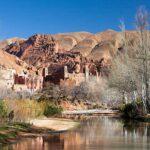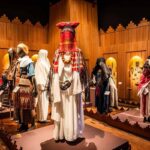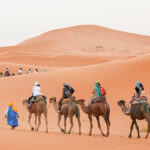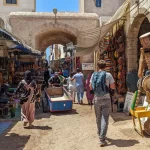Introduction
Imagine waking up in a lush, peaceful garden, surrounded by stunningly intricate tile work and the soft sounds of a fountain—this is the experience of staying in a riad. A cornerstone of Moroccan heritage, Riads are traditional homes turned guesthouses that offer more than just accommodation; they offer an immersive cultural journey. This article will delve into the charm and history of Riads, highlighting why they’re a superior choice for travelers seeking an authentic Moroccan experience.
Table of contents

What is a Riad?
A riad is a traditional Moroccan house or palace with a central courtyard or garden. The name comes from the Arabic word for garden, “ryad”. Designed for privacy, tranquility, and beauty, riads are typically two or more stories tall, with all windows facing inward towards the courtyard, a design that ensures both quiet and coolness in Morocco’s warm climate.
The Historical and Architectural Significance of Riads
Riads, with their origins deeply rooted in the rich soils of both the Maghreb and al-Andalus, are quintessential elements of traditional Moroccan architecture. These structures are typically built around a central courtyard, designed as a rectangular garden divided into four symmetrical quadrants. Central to these gardens is often a fountain, around which are paths intersecting at the garden’s heart. The garden areas are usually sunken, enhancing the aesthetic and cooling effect of these serene oases.
The architectural concept of the riad has historical ties to the traditional Persian gardens, which influenced Islamic architecture during the spread of Islamic culture. The term “riad” itself is derived from the Arabic word “Riyāḍ,” which means gardens. This design was not only prevalent in the historic Islamic world of the Middle East but was also a popular feature of palace architecture, embodying the paradisal visions described in Islamic spirituality.

In Morocco, the development of Riads was significantly influenced by the cultural and architectural exchanges across the Strait of Gibraltar, particularly with the Iberian Peninsula during the Islamic period. The Almoravids and later dynasties like the Almohads and the Saadians played a crucial role in incorporating these garden courtyards into the secular and palace architecture of the region. Notable examples include the grand Riads of the Badi Palace in Marrakesh, built in the late 16th century by Saadian sultan Ahmad al-Mansur, which was known for its expansive courtyard garden, symmetrical layout, and luxurious pavilions.
The riad gardens were perfected over centuries, becoming a standard feature of Moroccan architecture. They were particularly prominent in Marrakesh, where the local climate and urban layout were well-suited to this style. Today, these Riads serve not only as private residences but have often been transformed into luxurious guesthouses or hotels, offering visitors a taste of historical luxury and serene beauty in the heart of Morocco’s bustling cities. These restored traditional mansions are cherished for their beauty, tranquility, and the intimate connection they provide to Morocco’s rich historical tapestry.
The Role of Riads in Moroccan Culture
Riads are a living museum of Moroccan art and architecture but also play a crucial role in the cultural life of the city. They are often found in the Medina, or old town, of Moroccan cities, placing visitors at the heart of the city’s historical and cultural activities. Here, the past and present of Moroccan culture blend seamlessly, from the bustling souks nearby to the traditional music that might serenade you during dinner.

Experiencing Riads in Key Moroccan Cities
Each Moroccan city offers a unique riad experience, influenced by its history and local culture:
- Marrakech: Riads in Marrakech are often luxurious, a throwback to the city’s regal past, and located near the famous Marrakech Souks.
- Fes: Known for its ancient academic and religious institutions, Fes offers Riads that feel like stepping back in time, with many located in buildings several centuries old.
- Essaouira: Coastal Essaouira provides a breezy, relaxed riad experience with views of the sea and a lighter, airier architectural style.
- Chefchaouen: In the blue city of Chefchaouen, Riads mirror the serene and artistic spirit of the town with their calming blue interiors and mountain views.

- Rabat: As the capital, Rabat’s Riads often blend traditional style with more modern comforts, situated near important cultural sites.
- Tangier: At the crossroads of Africa and Europe, Tangier’s Riads reflect this mixture in their decor and atmosphere, offering views of the Strait of Gibraltar.
Types of Riads and Pricing
When planning your stay in Morocco, it’s important to understand the different types of Riads available, as they cater to a wide range of preferences and budgets. From budget bed and breakfast options to opulent luxury accommodations, each riad offers a unique experience. Here’s what you can expect across the spectrum:
Budget B&B Riads
For travelers looking to enjoy the authentic riad experience without breaking the bank, budget B&B Riads are an excellent choice. Prices for these accommodations can start as low as 30 Euros per night. These Riads typically offer basic amenities but maintain the charming characteristics of traditional Moroccan architecture and design. They provide a cozy, intimate setting that’s perfect for budget-conscious travelers who still wish to immerse themselves in Moroccan culture.
Mid-Range Riads
Mid-range Riads strike a balance between cost and comfort, offering more spacious accommodations and additional amenities such as air conditioning, a rooftop terrace, and sometimes a small dipping pool. These Riads often feature more elaborate decor, with intricate mosaics and beautifully carved wooden furnishings. Prices for mid-range Riads usually range from 100 to 300 Euros per night, depending on the location and the level of luxury provided.
Luxury Riads
At the high end of the spectrum are luxury Riads, which are the epitome of opulence and comfort. These establishments offer expansive suites, gourmet restaurants, and extensive amenities, including full-service spas with Hammams, large swimming pools, and lush gardens. Prices for a night in these luxurious surroundings can range from 300 to 600 Euros.
An example of a luxury riad is Villa Des Orangers in Marrakech. This exquisite riad combines the traditional Moroccan riad architecture with the amenities of a modern luxury hotel, including a spa, multiple pools, and a garden that offers a tranquil escape from the bustling city outside its walls.

Another notable mention is Riad Le Calife in Fes, which is nestled in the heart of the city. This charming riad offers an intimate setting with beautifully decorated rooms, a rooftop terrace with panoramic views of the historic Medina, and personalized service that makes guests feel like royalty.
Choosing the Right Riad
The choice of riad depends largely on your personal preferences and budget. For those who prefer a more personal, culturally rich experience, a budget or mid-range riad may be the perfect choice. Travelers seeking more comfort and luxury, perhaps for a special occasion or a more relaxing holiday, may opt for a luxury riad. Regardless of the price point, staying in a riad is an experience that offers a deeper connection to the Moroccan way of life and provides an authentic backdrop to explore the rich culture and history of this vibrant country.
Why Choose a Riad Over a Hotel?
Choosing a riad over a traditional hotel offers numerous benefits that enhance your travel experience:
- Authenticity: Riads provide a genuine insight into Moroccan life and architecture.
- Strategic Locations: Situated in historical centers, Riads make exploring cultural landmarks easy.
- Personalized Service: With fewer rooms than hotels, Riads offer a more personalized, intimate experience.
- Culinary Delights: Many Riads serve traditional Moroccan cuisine, offering an authentic taste of local dishes.
- Cultural Immersion: Staying in a riad means living amidst Moroccan art and history, offering a deeper connection to the place.
Conclusion
A riad is not just a place to stay; it’s a way to truly experience Morocco. Whether you’re exploring the best things to do in Marrakech, discovering the scholarly legacy of Fes, or soaking in the coastal charm of Essaouira, choosing a riad allows you to connect deeply with the Moroccan way of life. From the architecture to the hospitality, each riad tells a story, inviting you to become part of its narrative.
Plan Your Visit
Consider what each city and its Riads have to offer as you plan your trip to Morocco. From exploring ancient Medinas to enjoying local cuisine, every aspect of your stay in a riad will enrich your understanding and appreciation of this vibrant country.




































